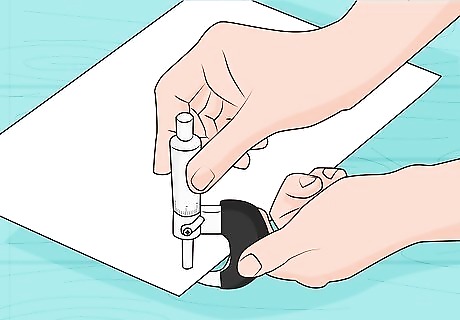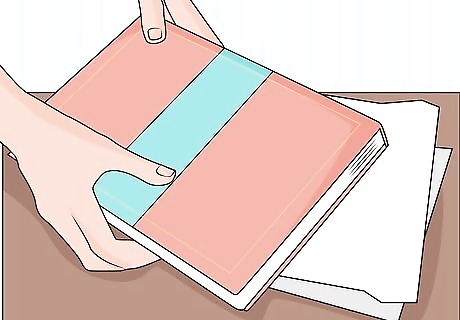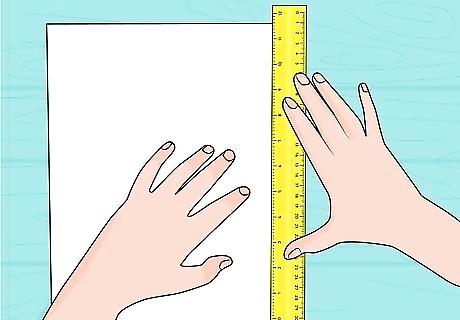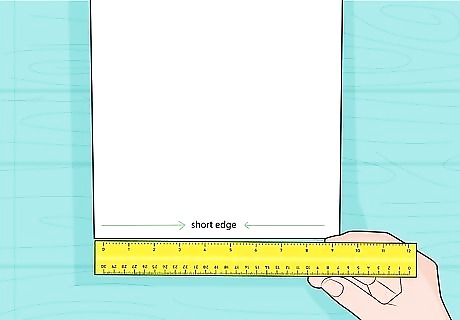
views
Figuring out the Thickness of Paper

Measure the height of stacked sheets of paper with a ruler. Because paper is so thin, it can be incredibly hard to figure out how thick a single sheet is. You can make this task easier by stacking together multiple sheets of paper, measuring the height with a ruler, and then dividing the height by the number of sheets you measured. For example, if you stack together 50 sheets of paper and find out they measure ⁄4 inch (6.4 mm) in height, divide .25 by 50. Each piece of paper is .005 inches (0.13 mm) thick. Finding the Volume of a Sheet of Paper: If you need to know the volume for a particular sheet of paper, multiply the length times the width times the height (or, the thickness of the sheet of paper). For example, the volume of an 8.5 by 11 in (220 by 280 mm) piece of paper that measures .005 inches (0.13 mm) thick is found by multiplying 8.5 x 11 x .0005, which equals 0.4675 cubic inches (7660 cubic millimeters).

Fold a sheet of paper multiple times if you don’t have a stack to measure. Take a single sheet of paper and fold it in half as many times as you can to create multiple layers. Use a ruler to measure the height and divide that number by how many layers you created. This method is the least accurate, but it’ll get you into the right range for your answer. For this method, it’s especially important that you get your folds to lay as flat as possible. You may want to stack a book on top of the paper or do something else to weigh it down so your measurement is accurate. If you’re worried about the creases and folds messing up your measurements, you could cut the paper into multiple pieces and stack them on top of each other instead.

Get a precise reading on a single sheet of paper by using a micrometer. Every brand of micrometer is a little different, but in general, you will place a sheet of paper between the clamps of the machine and put a small weight on top. The reading on the dial will tell you the thickness of that single sheet of paper. Always check your particular micrometer’s instructions to make sure it has been set up correctly. A micrometer can give you a measurement reading to the one-thousandth of an inch, which is really impressive and important if you need specific details! You could also use a dial caliper or vernier caliper to get the same results.
Measuring Length and Width

Lay out the piece of paper so that it is completely flat. If you’re measuring a newspaper or some other piece of paper that has been previously folded, you’ll need to flatten it out first before measuring it. You could flatten it under a book or use paperweights to hold down the edges. Measuring the length and width of a piece of paper can come in handy if you’re trying to purchase the right size frame for a picture or if you need to buy a folder or display case.

Use a ruler to measure the length of the paper from top to bottom. Line up the edge of the ruler so that it’s flush with the bottom of the piece of paper. Look at where the top of the paper meets the ruler to get the measurement. Use a ruler that includes both inches and centimeters so you can get the most accurate reading possible.

Place a ruler along the short edge of the paper to measure the width. Make sure the edge of the ruler is lined up with the edge of the piece of paper. Get the reading by looking at where the opposite side intersects with the ruler. Be sure to keep the edge of the ruler and the edge of the piece of paper together. Otherwise, the measurement won’t be accurate.

Write down the measurements on a piece of paper. Have a scrap piece of paper nearby so you can jot down the measurements. Or, you could always write them on the piece of paper itself with a pencil so it can be erased later if needed. To write the measurements, put the width and then the height. For example, a normal piece of printer paper is 8.5 by 11 inches (220 by 280 mm).

















Comments
0 comment